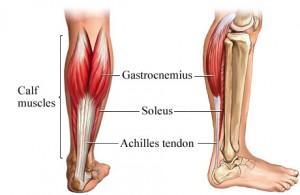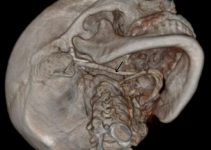Calf Pain is a very common medical condition annually affecting many people around the world. Know all about the causes, symptoms, diagnosis and treatment of this condition.
What Is Calf Pain?
Page Contents

Picture 1 – Calf Muscles Image
Source – unshodrunner
It is the pain that arises in the calf muscle located on the lower half of the leg. It is also known as “Calf Pull” or “Calf Strain”.
Calf Pain Causes
If you are suffering from a sharp pain in calf muscles of your leg, the causes of calf pain may be any of the following.
Trauma – Trauma to the calf muscles can put excessive strain on them and lead to an injury or trauma. A trauma can make you experience symptoms like acute pain, cramping or firmness in either or both calves of your legs. Calf injury is common after over-exertion of legs during exercise. Sharp calf pain while running for long hours is common. Many people also experience severe calf pain while walking.
Chronic Pain Disorders – Pain in calf may arise from chronic pain diseases such as arthritis and fibromyalgia. Unfortunately, these disorders tend to be ignored but can lead to complicated conditions.
Nervous Disorders – Calf pain in leg is often a result of nerve disorders like Multiple Sclerosis (MS), Diabetic Neurotherapy and Peripheral Neurotherapy.
Sleep Disorders – Sudden leg calf pain without any apparent cause such as over-exercise or chronic pain disorders may be a result of sleep disorders that you are probably unaware of. If you suffer from calf pain at night, you should probably get in touch with a doctor for proper diagnosis and treatment.
Circulation Problems – Pain in the leg calf muscles is often a result of poor circulation. Conditions like Varicose Veins, Arterial Insufficiency, Atherosclerosis, Venous Insufficiency and Deep Vein Thrombosis can cause this problem.
Calf Pain Symptoms
Some of the main symptoms of calf pain are
Pain – Pain is the main symptom of this condition. Upper calf pain as well as lower calf pain is mild in the initial stages but can be acute in the later period. Patients may also suffer from joint pain.
Spasms – There may be spasms or involuntary contraction of the muscles in the leg which can make sufferers unable to walk at times. This can also decrease the range of motion of the affected leg.
Numbness – Sufferers may also experience a numb sensation in the calf muscles. They may have a partial or total lack of sensation in the calf region.
Bumps on Skin – A number of skin bumps may arise on the affected leg region. There may also be discoloration or bruising of the skin over the calf area of the leg.
Inflammation – Pain in calf is also often accompanied by swelling in the region. The inflammation can be felt with hand in the initial stages and is clearly visible in later stages.
Weight Loss – Patients of this condition also suffer from sudden loss of weight.
Burning Sensation – There is also a burning feeling in the calf region of the legs.
Redness – Red blotches may arise on lumps or tender regions of the leg.
Pale Calf Skin – The skin over the calf region may turn pale or discolored. This area often turns bluish in color which suggests a lack of blood supply in the region.
Weakness – Sufferers also experience weakness in the calf area of the leg. In later stages the entire affected leg may be difficult to move.
Calf Pains are also associated with other symptoms like Varicose Veins, sleep disturbances and problems like sore throat, fever, fatigue, aches, cough and headache which are common in flu patients.
Calf Pain Problems
This condition is also marked by severe complications that can be life-threatening in the absence of treatment. These include
Respiratory Difficulties – Patients may suffer from respiratory difficulties such as shortness of breath and wheezing.
High Fever – People with this disease may also suffer from high body temperatures that may exceed 101 degrees Fahrenheit.
Change in Consciousness – Patients may experience a change in the level of their alertness. They may also suffer from mental confusion at times.
Calf Pain Location
The pain originates in the calf region of the legs or the fleshy tissue that can be found on the back of the lower part of each leg. The entire calf region extends from under the knee to just above the ankle.
Calf Pain Diagnosis
The initial diagnosis of this problem is done by physical observation of the affected leg. The patient is asked about the symptoms and his or her medical history. In some cases, such as in patients having pain behind knee and calf, tests like X-Ray Examination, Duplex Ultrasound Scan and Musculoskeletal Ultrasound may be conducted for a proper diagnosis.
Calf Pain Treatment
Calf pain cure is possible by sports injury professionals and doctors. If you experience tight calf muscle pain, you should get in touch with a professional healthcare provider. Calf muscle pain cure is usually done with anti-inflammatory medicines like Naproxen and Ibuprofen and analgesics (pain relievers) such as Acetaminophen. These drugs help reduce swelling and pain in the calf region of the affected leg.
Cure also involves avoiding stress on the muscle. It is necessary to avoid straining the region until the swelling reduces completely.
Remedies for Calf Pain
For sufferers of Calf Pain remedies at home involve
Compression Bandage – Wrapping a compression bandage around the affected area helps limit the inflammation. This is a common remedy for running calf pain. Remember not to wrap this too tightly around the calf region. Wound this gently or normal blood flow to the area may get restricted and lead to further problems.
Ice Therapy – Apply ice packs for four times every day once you start experiencing the symptoms. Apply ice for 20 minutes in every session. You should remember not to apply ice on the skin directly. Place a thin paper towel between skin and ice to avoid complications.
Massage the Area – Massage your calf region lightly with oil. This will improve blood flow in the region. If poor circulation is the result of your calf leg pain, lightly massaging the region for three to four times daily can improve blood flow into the area and help in calf pain recovery.
Calf leg pain is completely curable and goes away with effective treatment. If you are experiencing symptoms of this condition, try home remedies for 1-2 days. If there is no improvement in condition, it is best to go for an immediate medical treatment. This is even more necessary if you are experiencing other complicated symptoms like respiratory difficulties along with sharp pain in calf of leg. Early treatment will help you prevent all kinds of complications and get rid of painful symptoms very quickly.
References:
http://www.bettermedicine.com/article/calf-pain/causes?menu1=/diseasecenter.htm
http://www.wisegeek.com/what-are-the-most-common-causes-of-calf-pain.htm
http://symptoms.wrongdiagnosis.com/cosymptoms/calf-pain.htm
http://www.medhelp.org/posts/Chronic-Pain/Recurrent-severe-calf-pain—Bilateral/show/927564

